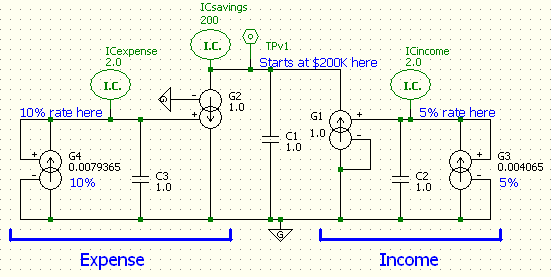Joe's Retirement:
Joe will soon retire with $200K of savings. His income at retirement
will be $2K per month. This income is expected to increase at a rate
of 5% per year. Joe's expenses are also $2K per month at retirement time.
These expenses are expected to increase at a yearly rate of 10%. How long
will Joe's savings last? Assume Interest on savings is small and can be
neglected. Use
Standard Simulation Conditions.
The circuit below is used to simulate Joe's savings. An initial condition (I.C.) component is used
to set 200 volts at capacitor C1. This sets Joe's initial savings at $200K. The Voltage Controlled
Current Source (VCCS) G1 is used to add income to capacitor C1 and the VCCS G2 will model Joe's
expenses by removing charge from C1. Both G1 and G2 start off at $2K per month of equivalent
current flow. This is done by using the "ICincome" and "ICexpense" component to set the
starting voltage at the G1 and G2 positive control terminals. The VCCS at G3 increases
the charge on C2 at a yearly rate of 5%. The VCCS at G4 increases the charge on C3 at a rate of 10%.
This causes the flow rate of G2 to increase at a faster rate than the flow rate of G1 causing
a net decrease in the amount of savings.

After the above schematic is entered, a SPICE description format is automatically generated
and simulated. This particular simulation took less than two seconds of computer time. The simulation result
is shown below.

Back

